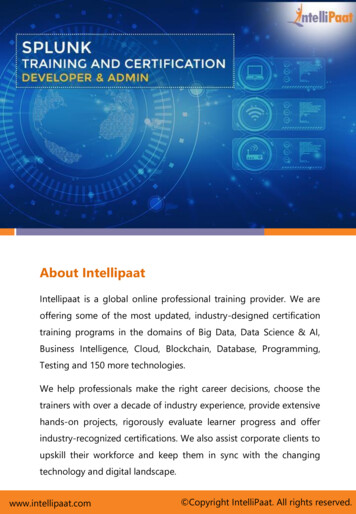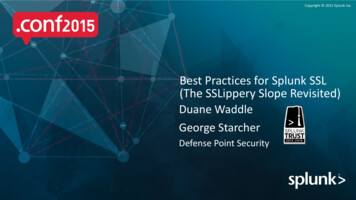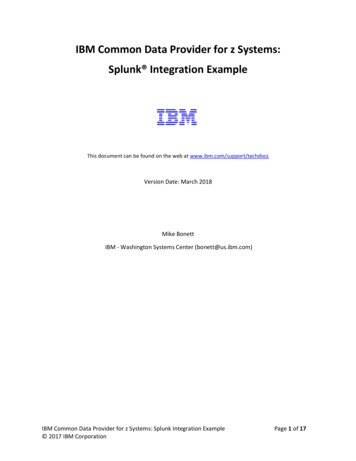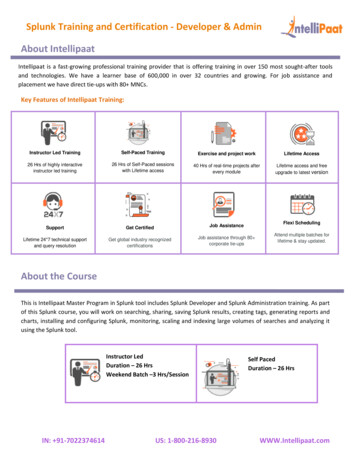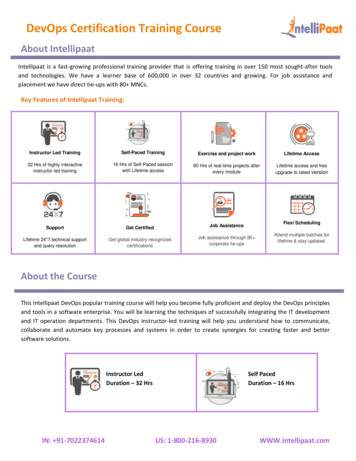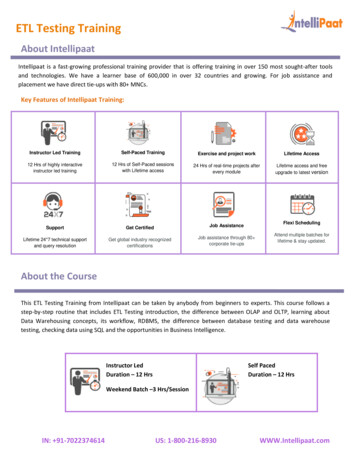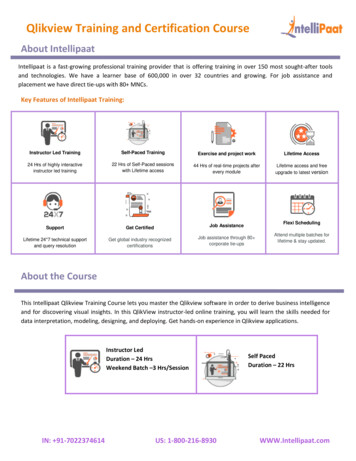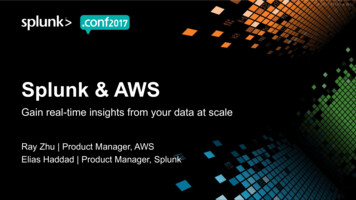
Transcription
Splunk Architect Master'sCertification TrainingSplunk Architect Master’s Certification Training1 Page
Table of Contents1.About the Program2.About Intellipaat3.Key Features4.Career Support5.Why take up this course?6.Who should take up this course?7.Program Curriculum8.Project Work9.Certification10.Intellipaat Success Stories11.Contact UsSplunk Architect Master’s Certification Training2 Page
About the ProgramIntellipaat offers Splunk online classes that include Splunk Developer, Administration, andSIEM components. This Splunk Architect master's program helps you learn Splunk searchand search commands, report creation, analyzing data with Splunk visualization, datamanagement, deploying Splunk SIEM for investigating and monitoring security solutions,and more.About IntellipaatIntellipaat is one of the leading e-learning training providers with more than 600,000learners across 55 countries. We are on a mission to democratize education as webelieve that everyone has the right to quality education.Our courses are delivered by subject matter experts from top MNCs, and our world-classpedagogy enables learners to quickly learn difficult topics in no time. Our 24/7 technicalsupport and career services will help them jump-start their careers in their dreamcompanies.Splunk Architect Master’s Certification Training3 Page
Key Features46 HRS INSTRUCTOR-LEDTRAINING46 HRS SELF-PACED TRAINING80 HRS REAL-TIMEPROJECT WORKLIFETIME ACCESS24/7 TECHNICAL SUPPORTINDUSTRY-RECOGNIZEDCERTIFICATIONJOB ASSISTANCE THROUGH80 CORPORATE TIE-UPSFLEXIBLE SCHEDULINGSplunk Architect Master’s Certification Training4 Page
Career SupportSESSIONS WITH INDUSTRY MENTORSAttend sessions from top industry experts and get guidance on how to boostyour career growthMOCK INTERVIEWSMock interviews to make you prepare for cracking interviews by top employersGUARANTEED INTERVIEWS & JOB SUPPORTGet interviewed by our 400 hiring partnersRESUME PREPARATIONGet assistance in creating a world-class resume from our career services teamSplunk Architect Master’s Certification Training5 Page
Why take up this course?Splunk is the most popular tool for working with machine data. It is also extensively usedfor security monitoring, analysis, and threat mitigation. Intellipaat’s Splunk master’sprogram is created to help you be a complete Splunk professional. Once you learn SplunkDeveloper and Administration domains, you will be qualified to learn the Splunk SIEMdomain. Upon the completion of the training, your skills will be highly demanded by theindustry, which will help you fast-track your career.Who should take up this course?Software Developers, System Administrators, Search Analysts, Security Professionals,Database Administrators, and others.Splunk Architect Master’s Certification Training6 Page
Program CurriculumSplunk Architect Master’s Training Course Content SPLUNK DEVELOPMENT CONCEPTS1.1 Introduction to Splunk and Splunk Developer roles and responsibilities BASIC SEARCHING2.1 Writing Splunk query for a search2.2 Auto-complete to build a search2.3 Time range2.4 Refining the search2.5 Working with events2.6 Identifying the contents of the search2.7 Controlling a search jobHands-on Exercise: Write a basic search query USING FIELDS IN SEARCHES3.1 What is a Field?3.2 How to use Fields in a search?3.3 Deploying Fields Sidebar and Field Extractor for REGEX field extraction3.4 Delimiting Field Extraction using FXHands-on Exercise: Use Fields in a search, use Fields Sidebar, use FieldExtractor (FX), and delimit field Extraction using FX SAVING & SCHEDULING SEARCHES4.1 Writing Splunk query for a search and sharing, saving, scheduling, andexporting search resultsHands-on Exercise: Schedule a search, save the search result, and share andexport the search resultSplunk Architect Master’s Certification Training7 Page
CREATING ALERTS5.1 How to create alerts5.2 Understanding alerts5.3 Viewing fired alertsHands-on Exercise: Create an alert in Splunk and view the fired alerts SCHEDULED REPORTS6.1 Understanding and configuring scheduled reports TAGS & EVENT TYPES7.1 Introduction to tags in Splunk7.2 Deploying tags for a Splunk search7.3 Understanding event types and utility7.4 Generating and implementing event types in the searchHands-on Exercise: Deploy tags for a Splunk search and generate and implementevent types in the search CREATING & USING MACROS8.1 What is a Macro?8.2 What are variables and arguments in Macros?Hands-on Exercise: Define a Macro with arguments and use variables within it WORKFLOW9.1 Creating get, post, and search workflow actionsHands-on Exercise: Create get, post, and search workflow actions SPLUNK SEARCH COMMANDS10.1 Understanding a search command10.2 General search practices10.3 What is a search pipeline?10.4 How to specify indexes in a search?10.5 Highlighting the syntaxSplunk Architect Master’s Certification Training8 Page
10.6 Deploying various search commands such as fields, tables, sort, rename,rex, and erexHands-on Exercise: Steps to create a search pipeline, search index specification,highlight the syntax, use the auto-complete feature, and deploy various searchcommands such as sort, fields, tables, rename, rex, and erex TRANSFORMING COMMANDS11.1 Using top, rare, and stats commandsHands-on Exercise: Use top, rare, and stats commands REPORTING COMMANDS12.1 Using the following commands and their functions: addcoltotals, addtotals,top, rare, and statsHands-on Exercise: Create reports using the following commands and theirfunctions: addcoltotals and addtotals MAPPING & SINGLE-VALUE COMMANDS13.1 Using iplocation, geostats, geom, and addtotals commandsHands-on Exercise: Track the IP using iplocation and the get geo data usinggeostats SPLUNK REPORTS & VISUALIZATIONS14.1 Exploring the available visualizations14.2 Creating charts and time charts14.3 Omitting null values and formatting resultsHands-on Exercise: Create time charts, omit null values, and format results ANALYZING, CALCULATING, & FORMATTING RESULTS15.1 Calculating and analyzing results15.2 Value conversion15.3 Rounding off and formatting values15.4 Using the eval commandSplunk Architect Master’s Certification Training9 Page
15.5 Using conditional statements15.6 Filtering calculated search resultsHands-on Exercise: Calculate and analyze results, perform the conversion of adata value, round off numbers, use the eval command, write conditional statements,and apply filters on calculated search results CORRELATING EVENTS16.1 How to search for transactions?16.2 Creating a report on transactions16.3 Grouping events using time and fields16.4 Comparing transactions with statsHands-on Exercise: Generate a report on transactions, and group events usingfields and time ENRICHING DATA WITH LOOKUPS17.1 Learning data lookups17.2 Examples and lookup tables17.3 Defining and configuring automatic lookups17.4 Deploying lookups in reports and searchesHands-on Exercise: Define and configure automatic lookups and deploy lookupsin reports and searches CREATING REPORTS & DASHBOARDS18.1 Creating search charts, reports, and dashboards18.2 Editing reports and dashboards18.3 Adding reports to dashboardsHands-on Exercise: Create search charts, reports, and dashboards, edit reportsand dashboards, and add reports to dashboards GETTING STARTED WITH PARSING19.1 Working with raw data for data extraction, transformation, parsing, andpreviewSplunk Architect Master’s Certification Training10 P a g e
Hands-on Exercise: Extract useful data from raw data, perform transformation,parse different values, and preview them USING PIVOT20.1 Understanding a pivot20.2 Relationship between a data model and a pivot20.3 Selecting a data model object20.4 Creating a pivot report20.5 Creating an instant pivot from a search20.6 Adding a pivot report to the dashboardHands-on Exercise: Select a data model object, create a pivot report, create aninstant pivot from a search, and add a pivot report to the dashboard COMMON INFORMATION MODEL (CIM) ADD-ON21.1 What is a Splunk CIM?21.2 Using the CIM add-on to normalize dataHands-on Exercise: Use the CIM add-on to normalize dataSplunk Administration Topics OVERVIEW OF SPLUNK22.1 Introduction to the architecture of Splunk22.2 Various server settings22.3 How to set up alerts22.4 Various types of licenses22.5 Important features of the Splunk tool22.6 The requirements of hardware and conditions needed for the installation ofSplunk SPLUNK INSTALLATION23.1 How to install and configure Splunk23.2 The creation of an index23.3 Standalone server’s input configurationSplunk Architect Master’s Certification Training11 P a g e
23.4 The preferences for a search23.5 Linux environment Splunk installation23.6 Administering and architecting Splunk SPLUNK INSTALLATION IN LINUX24.1 How to install Splunk in the Linux environment24.2 The conditions needed for Splunk24.3 Configuring Splunk in the Linux environment DISTRIBUTED MANAGEMENT CONSOLE25.1 Introducing Splunk distributed management console25.2 Indexing of clusters25.3 How to deploy a distributed search in the Splunk environment25.4 Forwarder management25.5 User authentication and access control INTRODUCTION TO THE SPLUNK APP26.1 Introduction to the Splunk app26.2 How to develop Splunk apps26.3 Splunk app management26.4 Splunk app add-ons26.5 Using Splunk-base for the installation and deletion of apps26.6 Different app permissions and implementation26.7 How to use the Splunk app26.8 Apps on forwarder SPLUNK INDEXES & USERS27.1 Index time configuration file27.2 Search time configuration file SPLUNK CONFIGURATION FILES28.1 Understanding the Index time and search time configuration files in Splunk28.2 Forwarder installation28.3 Input and output configurationSplunk Architect Master’s Certification Training12 P a g e
28.4 Universal Forwarder management28.5 Splunk Universal Forwarder highlights SPLUNK DEPLOYMENT MANAGEMENT29.1 Implementing the Splunk tool29.2 Deploying it on the server29.3 Splunk environment setup29.4 Splunk client group deployment SPLUNK INDEXES30.1 Understanding Splunk Indexes30.2 Default Splunk Indexes30.3 Segregating Splunk Indexes30.4 Learning Splunk buckets and bucket classification30.5 Estimating index storage30.6 Creating a new index USER ROLES & AUTHENTICATION31.1 Understanding the concept of role inheritance31.2 Splunk authentications31.3 Native authentications31.4 LDAP authentications SPLUNK ADMINISTRATION ENVIRONMENT32.1 Splunk installation and configuration32.2 Data inputs32.3 App management32.4 Splunk important concepts32.5 Parsing machine-generated data32.6 Search indexer and forwarder BASIC PRODUCTION ENVIRONMENT33.1 Introduction to Splunk configuration files33.2 Universal ForwarderSplunk Architect Master’s Certification Training13 P a g e
33.3 Forwarder management33.4 Data management, troubleshooting, and monitoring SPLUNK SEARCH ENGINE34.1 Converting machine-generated data into operational intelligence34.2 Setting up the dashboard, reports, and charts34.3 Integrating search head clustering and indexer clustering VARIOUS SPLUNK INPUT METHODS35.1 Understanding input methods35.2 Deploying scripted Windows and network35.3 Agentless input types and fine-tuning them all SPLUNK USER & INDEX MANAGEMENT36.1 Splunk user authentication and job role assignment36.2 Learning to manage, monitor, and optimize Splunk Indexes MACHINE DATA PARSING37.1 Parsing machine-generated data37.2 Manipulation of raw data37.3 Previewing and parsing37.4 Data field extraction37.5 Comparing single-line and multi-line events SEARCH SCALING & MONITORING38.1 Distributed search concepts38.2 Improving search performance38.3 Large-scale deployment and overcoming execution hurdles38.4 Working with Splunk Distributed Management Console for monitoring theentire operation SPLUNK CLUSTER IMPLEMENTATION39.1 Cluster indexing39.2 Configuring individual nodes39.3 Configuring cluster behavior, index behavior, and search behaviorSplunk Architect Master’s Certification Training14 P a g e
39.4 Setting up a node type to handle different aspects of a cluster such as themaster node, the peer node, and the search headSplunk SIEM Course Content INTRODUCTION TO SPLUNK SECURITYUnderstanding the fundamentals of Splunk security, details of traditional securitythreats, and describing correlation searches and the security data model INVESTIGATION & MONITORINGHow to monitor the dashboard and brief on each panel, investigating notable eventswith incident review dashboards, workflow investigation, and the relative action onthe identified flow INVESTIGATIONSDeploying ES investigation timelines for managing, visualizing and coordinatingincident investigations, using journals and timelines for documenting breachanalysis, and efforts needed to mitigate issues RISK & NETWORK ANALYSISDeploying risk analysis and identification, risk dashboard utilization, and how tomanage risk scores for objects and users WEB INTELLIGENCEUsing HTTP category analysis, HTTP user agent analysis, analyzing a new domain,analyzing the traffic size for spotting new threats, and highlighting investigableevents USER INTELLIGENCEAccessing the anomaly dashboards for user role and access logs and understandingidentity and asset concepts THREAT INTELLIGENCEMonitoring malicious sites with the threat activity dashboard and inspecting thethreat intelligence content with the threat artifact dashboardSplunk Architect Master’s Certification Training15 P a g e
Project WorkSplunk Architect Master’s ProjectsProject 1: Creating an Employee Database of a CompanyIndustry: GeneralProblem Statement: How to build a Splunk dashboard where employee details are readilyavailableTopics: In this project, you will create a text file of employee data with details such as fullname, salary, designation, ID, and so on. You will index the data based on variousparameters and use various Splunk commands for evaluating and extracting theinformation. Finally, you will create a dashboard and add various reports to it.Highlights: Splunk search and index commands Extracting a field in search and saving results Editing event types and adding tagsProject 2: Building an Organizational Dashboard with SplunkIndustry: E-commerceProblem Statement: Analyzing website traffic and gather insightsTopics: In this project, you will build an analytics dashboard for a website and create alertsfor various conditions. You will capture access logs of the web server and the sample logsand then will upload them. You will analyze the top 10 users, the average time spent, thepeak response time of the website, the top 10 errors, and the error code description. Youwill also create a Splunk dashboard for reporting and analyzing.Highlights: Creating bar and line charts Sending alerts for various conditionsSplunk Architect Master’s Certification Training16 P a g e
Providing admin rights for dashboardProject 3: Field Extraction in SplunkIndustry: GeneralProblem Statement: How to extract the fields from event data in SplunkTopics: In this project, you will learn to extract fields from events using the Splunk fieldextraction technique. You will gain knowledge in the basics of field extractions andunderstand the use of the field extractor, the field extraction page in Splunk web, and fieldextract configuration in files. You will learn the regular expression and delimiters method offield extraction. Upon the completion of the project, you will gain expertise in building theSplunk dashboard and using the extracted field data in it to create rich visualizations in anenterprise setup.Highlights: Field extraction using the delimiter method Delimit field extracts using FX Extracting fields with the search commandProject 4: A BPO Firm Wants to Secure Its Confidential DataIndustry: OutsourcingProblem Statement: How to ensure that an outsourcing firm does not fall prey to ITsecurity threatsTopics: In this project, you will work with the business process outsourcing firms’ machinegenerated data to look for suspicious activities, anomalies, and suspected threats. You willdeploy the Splunk SIEM tool for combing huge volumes of data and will deploy Splunkanalytics to come up with enterprise security reports and recommendations for securingthe activities of the enterprise.Highlights: Deploy Splunk Enterprise Security Investigate and monitor events Enterprise security model validationSplunk Architect Master’s Certification Training17 P a g e
CertificationAfter the completion of the course, you will get a certificate from Intellipaat.Splunk Architect Master’s Certification Training18 P a g e
Success StoriesKevin K WadaThank you very much for your top-class service. A special mentionshould be made for your patience in listening to my queries and givingme a solution, which was exactly what I was looking for. I am giving youa 10 on 10!Sampson BasoahThe Intellipaat team helped me in selecting the perfect course that suitsmy profile. The whole course was practically oriented, and the trainerswere always ready to answer any question. I found this course to beimpactful. Thank you.Nii AkaiMy overall training journey was good. The trainers were cooperative. All myquestions were quickly answered with a detailed explanation. I alwaysreceived more than what I had asked for. Thanks a lot.Sugandha SinhaIntellipaat's course instructors were excellent and well-versed with theirconcepts. The support team solved all my queries within the promised 24 hours.They explained all topics and concepts well, and the course material wasupdated and included videos, exercises, etc. I would highly recommendIntellipaat to those who wish to excel in the IT field.Vishal PentakotaThe best part of this course was the series of hands-on demonstrations thatthe trainer performed. Not only did he explain each concept theoretically, buthe also implemented all those concepts practically. Great job! A must go forbeginners.Splunk Architect Master’s Certification Training19 P a g e
CONTACT USINTELLIPAAT SOFTWARE SOLUTIONS PVT. LTD.BangaloreAMR Tech Park 3, Ground Floor, Tower B,Hongasandra Village, Bommanahalli,Hosur Road, Bangalore – 560068USA1219 E. Hillsdale Blvd. Suite 205,Foster City, CA 94404If you have any further queries or just want to have a conversation with us, then do call us.IND: 91-7022374614 US: 1-800-216-8930Splunk Architect Master’s Certification Training20 P a g e
Splunk Architect Master's Certification Training 3 P a g e About the Program Intellipaat offers Splunk online classes that include Splunk Developer, Administration, and SIEM components. This Splunk Architect master's program helps you learn Splunk search and search commands, report creation, analyzing data with Splunk visualization, data

